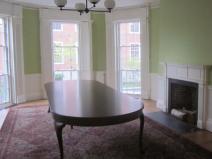Fay House - RAD
Fay House - RAD
Project highlights
• 87% of existing walls, floors, and roof were maintained during the renovation. • 35% reduction in overall water consumption as compared to EPACT 1992 baseline • 97% of all construction waste and debris was diverted from land-fills. • 39% salvaged, refurbished or reused materials as a percentage of total materials cost
Project summary
In June 2011, the Harvard Radcliffe Institute of Advanced Study began construction on the major renovation and restoration of the historic Fay House, originally built in 1807. Renovations to the building included mechanical and electrical systems upgrades, life safety and accessibility improvements, envelope restoration and modernization, deferred maintenance projects, and structural improvements. This provided Radcliffe with an opportunity to reconfigure the spaces to meet the building’s evolving programmatic requirements as well as increasing energy efficiency while improving indoor air quality. To further complicate the matter, these goals needed to be achieved while preserving the building’s historic features and character, inside and out. Once the original site of the Radcliffe College, the building now houses the Institute’s administration offices and is a contributing structure to the Old Cambridge National Register as well as the Harvard Planning Office’s Inventory of Interior Spaces with Cultural, Historic, or Artistic Merit, thereby requiring significant features to be maintained throughout the construction process. The completed project represents Harvard’s commitment to preserving its history while meeting the challenges of energy conservation and modern innovation. Sustainable building systems highlights include: ground source heat pumps, LED lights and sophisticated lighting controls, materials reuse, and a focus on responsible construction practices.


